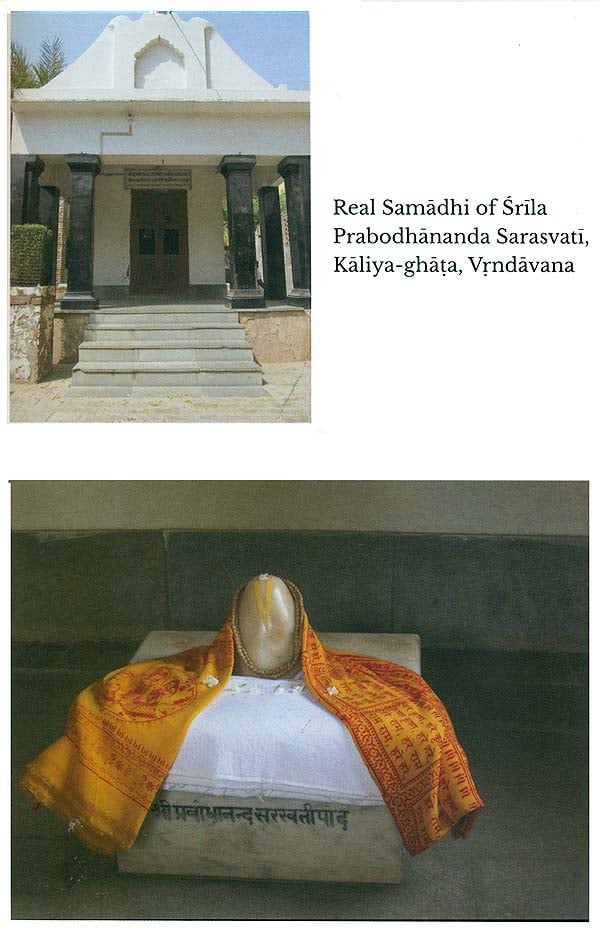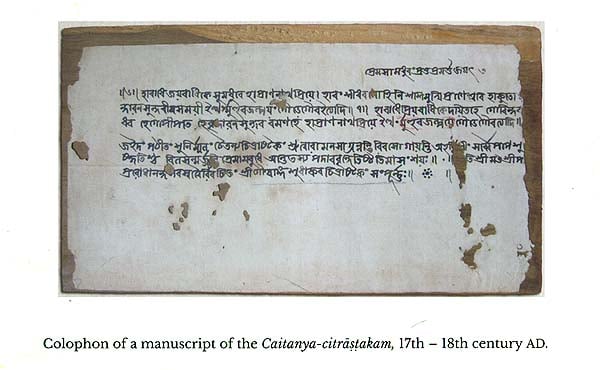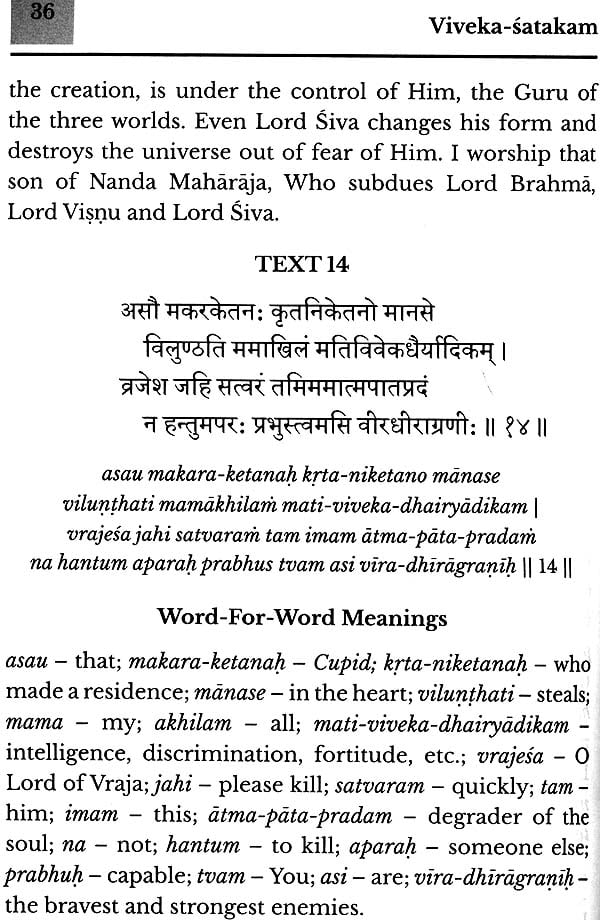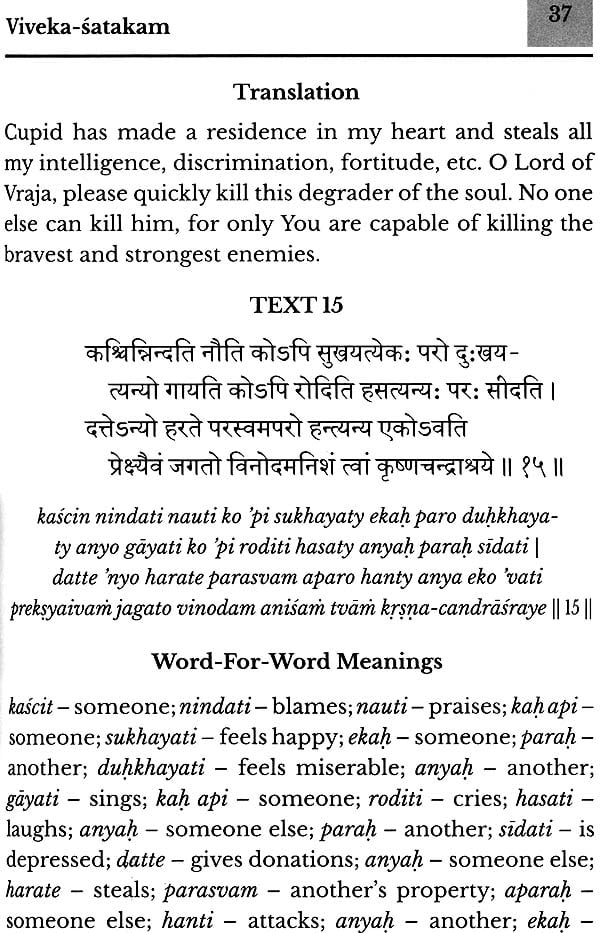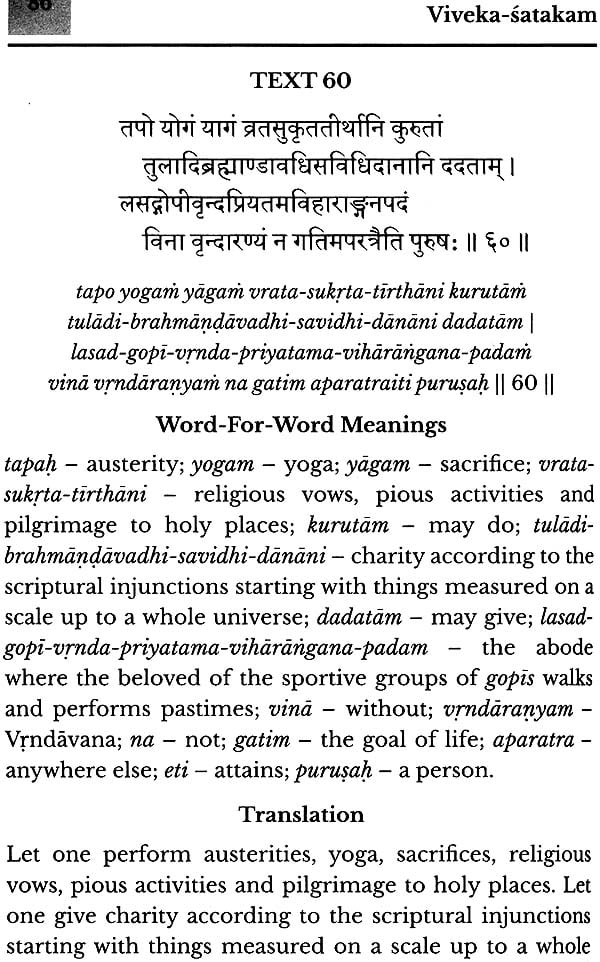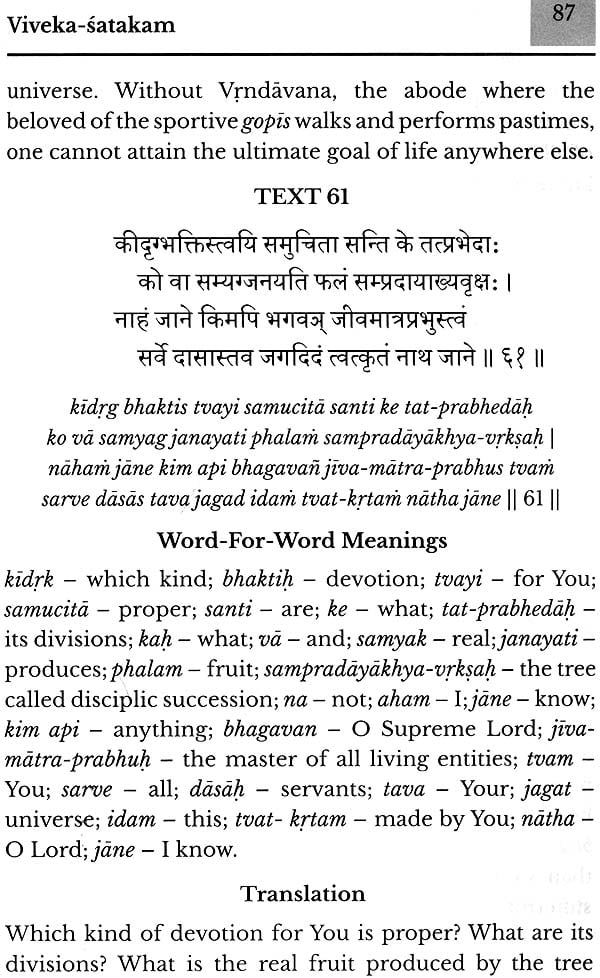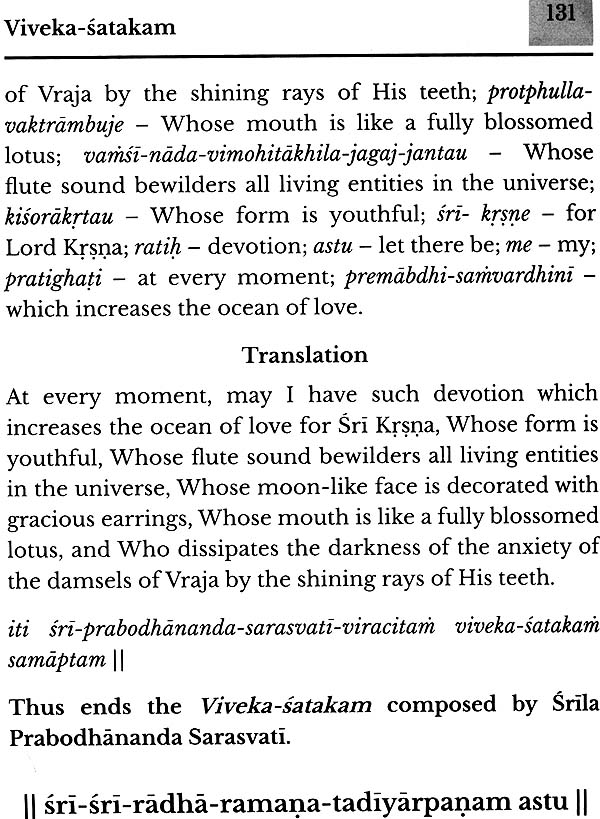
Viveka Satakam - A Hundred Verses of Wisdom
Book Specification
| Item Code: | NAN760 |
| Author: | Srila Prabodhananda Sarasvati |
| Publisher: | Bhakti Vikas Trust |
| Language: | Sanskrit Text With Transliteration and Word-to-Word Meaning English Translation |
| Edition: | 2017 |
| ISBN: | 9789382109426 |
| Pages: | 205 (5 Color Illustrations) |
| Cover: | Paperback |
| Other Details | 7.5 inch X 5.0 inch |
| Weight | 200 gm |
Book Description
This book is a trilogy of Srila Prabodhananda Sarasvati’s writings which were so far unknown to the public. In the logest of the three works, viveka satakam, the author repeatedly expresses his ardent desire to go to Vrndavana. In Caitanya-Citrastakam and Nityanandastakam he delightfully employs selected words of unalloyed ardous for his worshipable lords. Typical of Srila Prabodhananda Sarasvati, his devotional ecstasy as if leaps from his heart into his words and there from to the heart of they sympathetic leader.
By Srila Bhaktisiddhanta Sarasvati In the beginning of the Saka year of 1433 (1511 AD), on the pretext of a pilgrimage, Sri Krsna Caitanya Mahaprabhu distributed His mercy to the devotees. Starting in Niladri in Odisha, He first went to the Godavari confluence and then travelled through many holy places in the Madras area. On the Ekadasi day of the bright fortnight of Asadha month, Sriman Mahaprabhu was present in Srirangam. Seeing that the Caturmasya period had arrived, Lord Caitanya decided to stay in Sriranganatha Ksetra to observe the rules and regulations pertaining to the dasanami-sannyasis. That was a residential place of the Sri Vaisnavas. The Vaisnava sampradayas in South India maintain strong faith in religious observances. In South India there are villages inhabited by transcendentalists who worship Lord Visnu, and smarta brahmanas overlook all inconveniences to live there. In those days, Srirangam was a holy place inhabited only by Sri Vaisnavas. Therefore, Sriman Mahaprabhu spent four months in the company of those virtuous Vaisnavas, so surrendered and devoted to Lord Visnu, and by having darsana of Lord Ranganatha and preaching the transcendental topics on Lord Krsna, He instructed the souls there. At that time, three brothers from Mysore had come to live in Srirangam. They were called Tirumalaya, Vyenkata and Gopala-guru (Prabodhananda). Originally, they belonged either to Andhra Pradesh or Uttar Pradesh. Sriman Mahaprabhu was very pleased with this brahmana family and spent four months at their house. Vyenkata was the middle brother, and his son, Gopala Bhatta, who was then between five to ten years old, would later become one of the famous Cosvamis of Vrndavana.
The Sri Vaisnavas are mostly fond of worshipping Sri Laksmi-Narayana, By virtue of Sriman Mahaprabhu's special mercy, this Bhatta family became expert in relishing the rasas of Sri Krsna. Although we have no further information about Tirumalaya, it is understood that he was fully devoted to Lord Caitanya. The conversations between Lord Caitanya and Vyenkata are described in the ninth chapter of the Madhya - lila in the Caitanya Caritamrta. Prabodhananda had an incomparable attachment for Lord Caitanya. It was by the influence of the instruction received from Prabodhananda that Vyenkata's son, Gopala Bhatta, became an acarya among the Gaudiya Vaisnavas, Prabodhananda has a very elevated place among Lord Caitanya's servants. In his Gaura-ganoddesa-dipika, verse 163, Kavi Karnapura has stated:
tungavidya vraje yasit sarva-sastra-visarada
sa prabodhananda-yatir gaurodgana-sarasvati
"She who was previously known in the pastimes of Krsna in Vraja as Tungavidya, who is fully conversant with all scriptures, has now become Prabodhananda Sarasvati and is engaged in singing the glories of Lord Gauranga,"
In the beginning of the Hari-bhakti-vilasa (1.2) it is stated:
bhakter vilasams cinute prabodhanandasya sisyo bhagavat-priyasya
Gopala-bhatto raghunatha-dasam santosayan rupa-sandtanau ca
“Gopala Bhatta, disciple of Srila Prabodhananda, a dear associate of Lord Caitanya, is compiling this Hari-bhakti- vilasa to please Srila Rupa Gosvami, Srila Sanataria Gosvami and Srila Raghunatha Dasa Gosvami,"
In his Bhakti-ratniikara (1.149-150,152,153), Narahari Cakravarti says:
keha kahe prabodhanandera guna ati
sarvatra haila yamra khyati sarasvati
purna-brahma sri-krsna-caitanya bhagavan
tamra priya, tdmra vina svapane nahi ana
parama-vairagya-sneha murti manorama
maha-kavi, gita-vadya-nrtya anupama
yamhara vakya suni' sukha badaye sabara
prabodhanandera maha-mahima apdra
Some say that Prabodhananda had many virtues. He became famous everywhere as 'Sarasvati,' Even in dreams e did not know anyone else besides Sri Krsna Caitanya, le Supreme Brahman, Who was so dear to him. He was fascinating, supremely detached, affection personified, a great poet and incomparable in dance and music, both vocal and instrumental. He would increase the happiness of those who heard him speak. Prabodhananda's glories are immense."
When Sriman Mahaprabhu returned to Nilacala, in the subsequent years Prabodhananda Sarasvati became absorbed in intensely and wholeheartedly worshipping Him. Giving up Srirangam, He first took shelter of Lord Caitanya, and keeping in mind his desired mode of worship, without delay he went to live in Kamyavana in the Mathura district. Meanwhile, Copala Bhatta also gradually developed an intense desire to live in Vraja- dhama and later followed in his uncle's footsteps.
As if influenced by the worldwide dominance of sudra culture, very few Gaudiya Vaisnavas today have even an inkling of the tremendous scholarly heritage to which they are heirs. And even if informed of it, very few take interest, as if it has nothing to do with them. But factually, service to the literary contributions of the previous acaryas is a major area of devotional service that if neglected by the whole Vaisnava community constitutes a collective offense known as guror avajna, neglecting the gurus.
There is practically unlimited work to do in collecting, preserving, reproducing, translating, and commenting on old manuscripts, and in many other scholarly fields also. It is regrettable that much of the Vaisnava world today is more inclined toward adapting Krsna consciousness to mleccha society rather than understanding and embracing our own glorious and fully spiritual tradition.
Symptomatic of this is that despite the ongoing massive recruitment achievements of Srila A. C. Bhaktivedanta Swami Prabhupada and his followers, only a very few within his community have shown serious interest in Vaisnava scholarship - and most of those few have opted to pander to the largely agnostic secular academia. Hence appreciation is due to Bhakta Demian (Dr. Demian Martins) for dedicating his life to one major area of research-the legacy of Gaudiya Vedantacarya Srila Baladeva Vidyabhusana-which he is conducting in the straightforward traditional manner of a committed devotee, shunning the pretensions and prejudices of secular academia.
From my own dabblings in scholarly research, I came to learn what probably all serious researchers have experienced: sometimes while exploring in one area, one stumbles across another huge field of investigation in related or sometimes even distant topics. Thus it is that Bhakta Demian has taken an aside from his life's focus on Srila Baladeva Vidyabhusana to publish this important book, which brings to light some largely unknown writings of Srila Prabodhananda Sarasvati.
Particularly valuable herein is Bhakta Demian's research and analysis concerning the identity of Srila Prabodhananda Sarasvati, which sheds new light on a long- standing controversy by making clear that the contention of certain polemicists has very little credibility. Followers of Srila Bhaktisiddhanta Sarasvati Thakura glorify him as ropanuga-viruddhapasiddhanta-dhvanta-hari, "the remover of the darkness of faulty conclusions that oppose those of the followers of Srila Rupa Gosvami'' - which he did by establishing sat-siddhanta (proper philosophical conclusions), down to the minutest detail. It is in this tradition that Bhakta Demian has compiled this book, and naturally in doing so he also glorifies Srila Prabodhananda Sarasvati and the subsequent acaryas who have glorified him.
Srila Prabodhananda Sarasvati's poetic adoration of Sri Caitanya Mahaprabhu, Sri Radha, Sri Vrndavana -dhama, and Sri Navadvipa-dhama, in his famous works Sri Radha- rasa-sudha-nidhi, Sri Caitanya-candramrta, Vrndavana- sataka, and Navadvipa-sataka; is unprecedented in its unique ebullience. Among his other works are Sangita- Madhava, Ascarya-rasa-prabandha, Sruti-stuti-vyakhya, Gita- govinda-vyakhyana, Kama-bija-kama-gayatri-vyakhyana, and a commentary on Gopala-tapani Upanisad. The present book is actually a trilogy of Srila Prabodhananda Sarasvati's writings which were so far unknown to the public. In the longest of the three works, Viveka-satakam, the author repeatedly expresses his ardent desire to go to Vrndavana. In Caitanya-citrastakam and Nityanandastakam he delightfully employs selected words of unalloyed ardour for his worshipable Lords. Typical of Srila Prabodhananda Sarasvati, his devotional ecstasy as if leaps from his heart into his words and there from to the heart of the sympathetic reader.
By traveling the length and breadth of India, often accepting very austere conditions in the course of undertaking perseverant, meticulous research, and by locating, translating, and publishing the manuscripts featured herein, Bhakta Demian has been able to perform this notable service of adding to the known canon of Srila Prabodhananda Sarasvati. All Gaudiyas should be grateful to him for these contributions. May our acaryas continue to bless him in his ongoing endeavours. We look forward to more such publications from him in the coming years.
According to several accounts, Srila Prabodhananda Sarasvati was a dear associate of Lord Caitanya Mahaprabhu and was also one of the pioneers in praising His glories in Sanskrit poetry in his book named Caitanya-candrdmrta. At the same time, his figure is one of the most controversial among the Gaudiyas. The utter silence of Srila Krsnadasa Kaviraja and Srila Vrndavanadasa Thakura about Prabodhananda led to different conjectures, and the conflicting narrations of later Gaudiya hagiographers overshadowed him in a cloud of mystery and confusion. We find no date of his birth, demise, travels or any incident of his life, about which there is hardly anything known, apart from whatever is mentioned in his own writings and the terse verses of a few other authors. Furthermore, none of the works attributed to Prabodhananda seem to have ever been quoted by his contemporaries or other Gaudiyas until the 18th century. Most of his writings were unknown until they started to be published in late 19th century. In particular, two controversies have been prevalent for over a century - his alleged past as a mayavadi sannyasi in Varanasi under the name 'Prakasananda Sarasvati,' and his supposed relation with Sri Hita Harivamsa, founder of the Radha-vallabha-sampradaya. In order to establish a plausible conclusion, it is commendable to first go through an overview of the available data and assess its integrity. What follows comprises most of the statements about Prabodhananda Sarasvati made by notable authors between the 16th and the 18th centuries.
From his own statement, we know that Gopala Bhatta Gosvami was a disciple of Prabodhananda Sarasvati, the only one we hear of, although it is not clear whether he was his siksa-guru, diksa-guru or both. From other sources we also hear that they had a blood connection as uncle and nephew. Yet in the works attributed to Gopala Bhatta, Prabodhananda's name is mentioned only once. At the beginning of the Hari-bhakti-vilasa (1.2) it is written:
bhakter vilasams cinute prabodhanandasya sisyo bhagavat- priyasya gopala-bhatto raghunatha-dasam santosayan rupa- sanatanau ca
"Gopala Bhatta, disciple of Srila Prabodhananda, a dear associate of Lord Caitanya, is compiling this Hari-bhakti- vilasa to please Srila Rupa Gosvami, Srila Sanatana Gosvami and Srila Raghunatha Dasa Gosvami,"
In the commentary attributed to Srila Sanatana Gosvami it is stated:
bhagavat-priyasyeti bahuvrihina tatpurusena va samasena tasya mahatmya-jatam pratipaditam I evam tac-chisyasya Sri- gopala-bhattasyapi tadrktvam boddhavyam I
"By the words bhagavat-priyasya, which can be interpreted either as a bahuvrihi compound (to whom Lord Caitanya is very dear) or as a tatpurusa compound (who is very dear to Lord Caitanya), Sri Prabodhananda's glories are expressed. ln the same way, the glories of his disciple, Sri Gopala Bhatta, are understood to be similar to his."
In the Gaura-ganoddesa-dipika, Kavi Karnapura enumerated the main associates of Lord Caitanya and their respective Identities in krsna-lila. In verse 163 he says:
tungavidya vraje yasit sarva-sastra-visarada
sa prabodhananda-yatir gaurodgana-sarasvati
'She who was previously known in the pastimes of Krsna In Vraja as Tungavidya, who is fully conversant with all scriptures, has now become Prabodhananda Sarasvati and is engaged in singing the glories of Lord Gauranga,"
As Prabodhananda is identified as one of the main eight Gopis of Vraja, it is understood that such an intimate associate must have played an essential role in caitanya- lila. From the statements of Sanatana Gosvami and Karnapura it is implied that Prabodhananda had the association of Lord Caitanya at some point of life. Since Ne find no descriptions of their meeting in Navadvipa rr Purl, the most obvious conclusion is that they spent our months together in Srirangam during the Lord's south Indian tour, as pointed out by the texts quoted below. There are no other instances of the Lord spending so much time in a family's house, which means the Bhatta family was very special and dear to Him. By the name 'Tungavidya' (she who has exalted knowledge) we can also understand that Prabodhananda was conversant with spiritual knowledge, which he imparted to his disciple Gopala, who subsequently became the main initiator spiritual master in Vrndavana. From these two perspectives, Prabodhananda holds indeed a very distinguished position in the pastimes of Lord Caitanya.
At the end of his commentary on the Gopala-tapany- upanisad, Srila Jiva Gosvami states:
visvesvaraka-janardana-bhattabhyam vaidikacaryabhyam |
tadvat prabodha-yatina likhitam citram atra taratamyena ||
sri-sanatana-rupasya caranabja-sudhepsuna |
purita tippani ceyam jivena sukha-bodhini ||
"Previously, the Vedic preceptors named Visvesvara and janardana Bhatta, as well as the sannyasi Prabodha have written commentaries on this text, each more interesting than the previous one. Now this commentary called Sukha-bodhini has been completed by Jiva, desiring to obtain the nectarine water from the feet of Srila Rupa and Srila Sanatana Gosvamis,"
There is a work attributed to Jiva Gosvami named Vaisnava-vandana, where we find the following verse (71)
prabodhananda-sarasvatim vande vimalam yaya muda |
candramrtam racitam yac-chisyo gopala-bhattakah ||
"I offer my humble obeisances unto the spotless Srila: Prabodhananda Sarasvati, who joyfully compiled the Caitanya-candramrta, and whose disciple is Srila Gopal: Bhatta Gosvami."
| Foreword by Bhakti Vikasa Swami | vii |
| About the Author by Bhaktisiddhanta Saraswati | xi |
| Introduction | xxv |
| Sri Caitanya-Citrastakam | 1 |
| Sri Nityanandastakam | 12 |
| Viveka-satakam | 22 |
| Baladeva Vidyabhusana Project | 133 |
